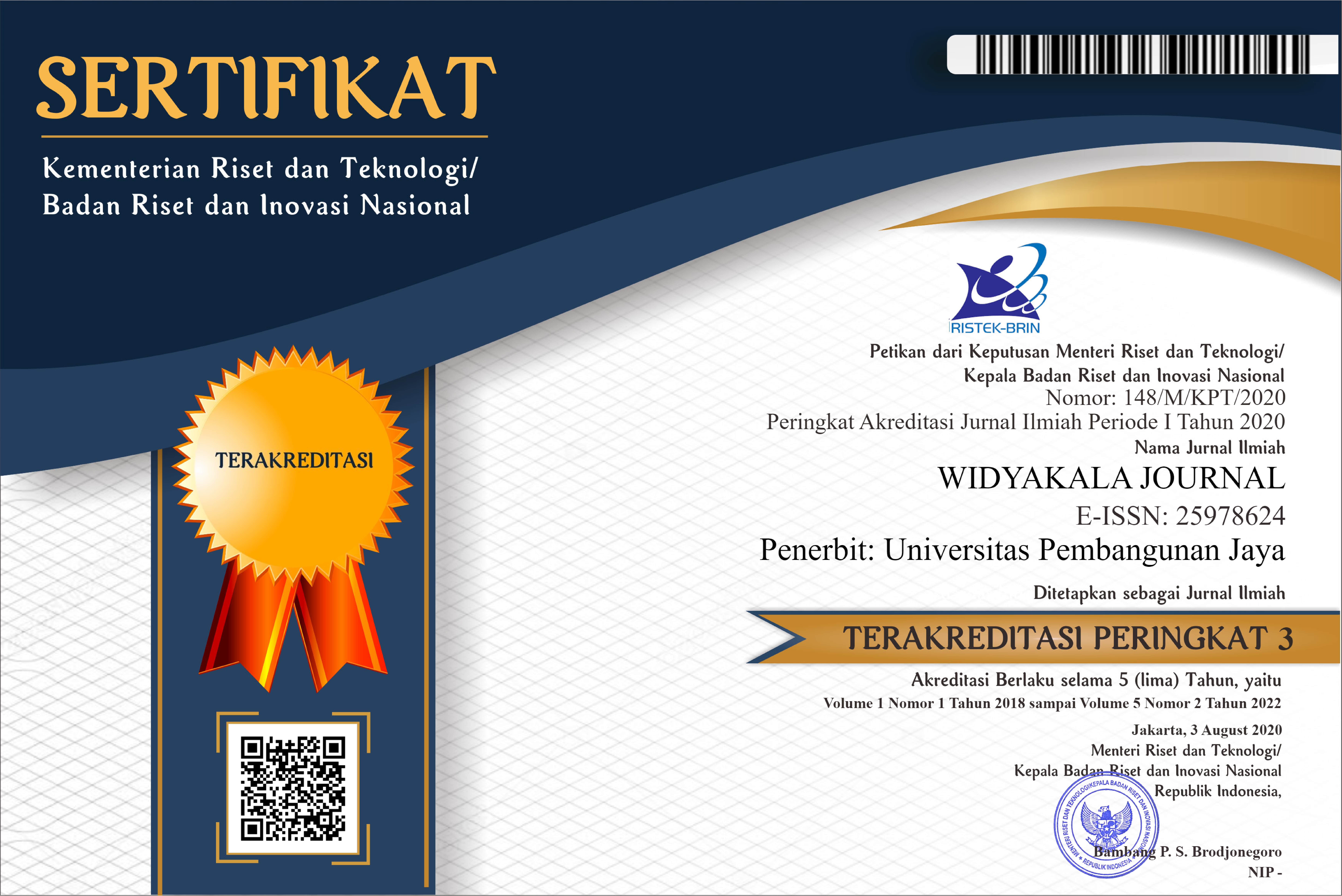Updated, March 2025
Faktor-Faktor yang Memengaruhi Pengalaman dan Kepuasan Pelanggan Perkotaan dalam Pembelian Melalui M-commerce
Abstract
Penelitian ini bertujuan untuk menginvestigasi faktor-faktor yang memengaruhi pengalaman dan kepuasan pelanggan perkotaan pada pembelanjaan melalui perangkat mobile (m-commerce). Penelitian ini mengambil populasi dari pelanggan Shopee yang bertempat tinggal di Jakarta dan pernah melakukan pembelian melalui aplikasi mobile Shopee di telepon genggam atau tablet. Data diambil dari 188 responden. PLS SEM digunakan untuk menganalisis data dan menguji hipotesis penelitian. Hasil penelitian ini adalah kualitas layanan berpengaruh positif terhadap pengalaman dan kepuasan pelanggan, perceived risk berpengaruh negatif terhadap kepuasan pelanggan dan pengalaman pelanggan berpengaruh positif terhadap kepuasan pelanggan. Implikasi praktis dari penelitian ini adalah pelaku bisnis m-commerce harus dapat meningkatkan kualitas layanannya, mengurangi perceived risk dari m-commerce yang mereka kelola, dan juga meningkatkan pengalaman pelanggan untuk membuat pelanggan mereka puas.
Keywords
Full Text:
PDFReferences
Appinventiv. (2020). Future of Mobile Commerce: Stats & Trends to Know in 2020-2025. Retrieved February 1, 2020, from https://appinventiv.com/blog/mobile-commerce-trends-infographics/
Boo, H. V., Lee, N., & Murray, D. (2014). Sports service quality for event venues: evidence from Malaysia. Sport, Business and Management: An International Journal, 4(2), 125–141. https://doi.org/10.1108/SBM-11-2010-0020
Boon-itt, S. (2015). Managing self-service technology service quality to enhance e-satisfaction. International Journal of Quality and Service Sciences, 7(4), 373–391. https://doi.org/10.1108/IJQSS-01-2015-0013
Carù, A., & Cova, B. (2003). Revisiting consumption experience: A more humble but complete view of the concept. Marketing Theory, 3(2), 267–286. https://doi.org/10.1177/14705931030032004
Chaney, D., Lunardo, R., & Mencarelli, R. (2018). Consumption experience: past, present and future. Qualitative Market Research, 21(4), 402–420. https://doi.org/10.1108/QMR-04-2018-0042
Chang, E. C., & Tseng, Y. F. (2013). Research note: E-store image, perceived value and perceived risk. Journal of Business Research, 66(7), 864–870. https://doi.org/10.1016/j.jbusres.2011.06.012
Chang, H. H., & Chen, S. W. (2008). The impact of online store environment cues on purchase intention: Trust and perceived risk as a mediator. Online Information Review, 32(6), 818–841. https://doi.org/10.1108/14684520810923953
Chang, S. H., Chih, W. H., Liou, D. K., & Yang, Y. T. (2016). The mediation of cognitive attitude for online shopping. Information Technology and People, 29(3), 618–646. https://doi.org/10.1108/ITP-08-2014-0172
Chen, X., & Li, S. (2017). Understanding continuance intention of mobile payment services: An empirical study. Journal of Computer Information Systems, 57(4), 287–298. https://doi.org/10.1080/08874417.2016.1180649
Cronin, J. J., Brady, M. K., & Hult, G. T. M. (2000). Assessing the effects of quality, value, and customer satisfaction on consumer behavioral intentions in service environments. Journal of Retailing, 76(2), 193–218. https://doi.org/10.1016/S0022-4359(00)00028-2
Forsythe, S., Liu, C. L., Shannon, D., & Gardner, L. C. (2006). Devolopment of a scale to measure the perceived benefits and risks of online shopping. Journal of Interactive Marketing, 20(2), 55–75. https://doi.org/10.1002/dir
Forsythe, S. M., & Shi, B. (2003). Consumer patronage and risk perceptions in Internet shopping. Journal of Business Research, 56(11), 867–875. https://doi.org/10.1016/S0148-2963(01)00273-9
Gentile, C., Spiller, N., & Noci, G. (2007). How to Sustain the Customer Experience: An Overview of Experience Components that Co-create Value With the Customer. European Management Journal, 25(5), 395–410. https://doi.org/10.1016/j.emj.2007.08.005
Giannoulakis, C., Wang, C. H., & Felver, N. (2015). A modeling approach to sport volunteer satisfaction. International Journal of Event and Festival Management, 6(3), 182–199. https://doi.org/10.1108/IJEFM-04-2014-0010
Gustafsson, A., Johnson, M. D., & Roos, I. (2005). The Effects of Customer Satisfaction, Relationship Commitment Dimensions, and Triggers on Customer Retention. Journal of Marketing, 69(4), 210–218. https://doi.org/10.1509/jmkg.2005.69.4.210
Hair, J. F., Ringle, C. M., & Sarstedt, M. (2011). PLS-SEM: Indeed a silver bullet. Journal of Marketing Theory and Practice, 19(2), 139–151. https://doi.org/10.2753/MTP1069-6679190202
Hair, J. F., Sarstedt, M., Ringle, C. M., & Mena, J. A. (2012). An assessment of the use of partial least squares structural equation modeling in marketing research. Journal of the Academy of Marketing Science, 40(3), 414–433. https://doi.org/10.1007/s11747-011-0261-6
Heejun, P., & Seung, B. (2007). Measuring service quality of online bookstores with WebQual. Jack, J.A. (Ed.), Human-Computer Interaction. HCI Applications and Services, Springer, Heidelberg, 4553 LNCS(PART 4), 95–103. https://doi.org/10.1007/978-3-540-73111-5_12
Holbrook, M. B., & Hirschman, E. C. (1982). The Experiential Aspects of Consumption: Consumer Fantasies, Feelings, and Fun. Journal of Consumer Research, 9(2), 132–140. https://doi.org/10.1086/208906
Khoo, S., Ha, H., & McGregor, S. L. T. (2017). Service quality and student/customer satisfaction in the private tertiary education sector in Singapore. International Journal of Educational Management, 31(4), 430–444. https://doi.org/10.1108/IJEM-09-2015-0121
Kim, M. S., Shin, D. J., & Koo, D. W. (2018). The influence of perceived service fairness on brand trust, brand experience and brand citizenship behavior. International Journal of Contemporary Hospitality Management, 30(7), 2603–2621. https://doi.org/10.1108/IJCHM-06-2017-0355
Klaus, P. & Maklan, S. (2012). EXQ: A multiple-item scale for assessing service experience. Journal of Service Management, 23(1), 5–33. https://doi.org/10.1108/09564231211208952
Koetz, C. (2019). Managing the customer experience: a beauty retailer deploys all tactics. Journal of Business Strategy, 40(1), 10–17. https://doi.org/10.1108/JBS-09-2017-0139
Kompas.com. (2018). Sejak Sepuluh Tahun Lalu, Perilaku Konsumen. Retrieved March 5, 2020, from https://ekonomi.kompas.com/read/2018/01/15/164037926/sejak-sepuluh-tahun-lalu-perilaku-konsumen
Kumar, V., Pozza, I. D., & Ganesh, J. (2013). Revisiting the satisfaction-loyalty relationship: Empirical generalizations and directions for future research. Journal of Retailing, 89(3), 246–262. https://doi.org/10.1016/j.jretai.2013.02.001
Lainamngern, S., & Sawmong, S. (2019). How customer relationship management, perceived risk, perceived service quality, and passenger trust affect a full-service airline’s passenger satisfaction. Journal of Business & Retail Management Research, 13(03), 160–177. https://doi.org/10.24052/jbrmr/v13is03/art-15
Laukkanen, T., & Kiviniemi, V. (2010). The role of information in mobile banking resistance. International Journal of Bank Marketing, 28(5), 372–388. https://doi.org/10.1108/02652321011064890
Levy, M., Weitz, B. ., & Grewal, D. (2015). Retail Management (9th ed.). New York: McGraw- Hill Education.
Liao, C., Lin, H. N., & Liu, Y. P. (2010). Predicting the use of pirated software: A contingency model integrating perceived risk with the theory of planned behavior. Journal of Business Ethics, 91(2), 237–252. https://doi.org/10.1007/s10551-009-0081-5
Lin, Y., Luo, J., Cai, S., Ma, S., & Rong, K. (2016). Exploring the service quality in the e-commerce context: A triadic view. Industrial Management and Data Systems, 116(3), 388–415. https://doi.org/10.1108/IMDS-04-2015-0116
Littler, D., & Melanthiou, D. (2006). Consumer perceptions of risk and uncertainty and the implications for behaviour towards innovative retail services: The case of Internet Banking. Journal of Retailing and Consumer Services, 13, 431–443.
Mahapatra, S. (2017). Mobile shopping among young consumers: an empirical study in an emerging market. International Journal of Retail & Distribution Management, IJRDM-08-2016-0128. https://doi.org/10.1108/IJRDM-08-2016-0128
Mbama, C. I., & Ezepue, P. O. (2018). Digital banking, customer experience and bank financial performance: UK customers’ perceptions. International Journal of Bank Marketing, 36(2), 230–255. https://doi.org/10.1108/IJBM-11-2016-0181
Meuter, M. L., Ostrom, A. L., Bitner, M. J., & Roundtree, R. (2003). The influence of technology anxiety on consumer use and experiences with self-service technologies. Journal of Business Research, 56(11), 899–906. https://doi.org/10.1016/S0148-2963(01)00276-4
Meyer, C., & Schwager, A. (2007). Understanding customer experience. Harvard Business Review, February, 117–126.
Mohd-Ramly, S., & Omar, N. A. (2017). Exploring the influence of store attributes on customer experience and customer engagement. International Journal of Retail and Distribution Management, 45(11), 1138–1158. https://doi.org/10.1108/IJRDM-04-2016-0049
Nguyen, Q., Nisar, T. M., Knox, D., & Prabhakar, G. P. (2018). Understanding customer satisfaction in the UK quick service restaurant industry: The influence of the tangible attributes of perceived service quality. British Food Journal, 120(6), 1207–1222. https://doi.org/10.1108/BFJ-08-2017-0449
Oliver, R. L. (1980). A Cognitive Model of the Antecedents and Conseqences of Satisfaction Decisions. Journal of Marketing Research (JMR), 17(4), 460–469.
Otto, J. E., & Ritchie, J. R. B. (1996). The service experience in tourism. Tourism Management, 17(3), 165–174. https://doi.org/10.1016/0261-5177(96)00003-9
Pine II, J. B., & Gilmore, J. H. (2000). Satisfaction, sacrifice, surprise: three small steps create one giant leap into the experience economy. Strategy & Leadership, 28(1), 18–23.
Pizam, A., Shapoval, V., & Ellis, T. (2016). Customer satisfaction and its measurement in hospitality enterprises: a revisit and update. International Journal of Contemporary Hospitality Management, 28(1), 2–35. https://doi.org/10.1108/IJCHM-04-2015-0167
Poromatikul, C., De Maeyer, P., Leelapanyalert, K., & Zaby, S. (2020). Drivers of continuance intention with mobile banking apps. International Journal of Bank Marketing, 38(1), 242–262. https://doi.org/10.1108/IJBM-08-2018-0224
Rahman, M. S., Mannan, M., Hossain, M. A., & Zaman, M. H. (2018). Patient’s behavioral intention: public and private hospitals context. Marketing Intelligence and Planning, 36(3), 349–364. https://doi.org/10.1108/MIP-08-2017-0155
Rajaguru, R. (2016). Role of value for money and service quality on behavioural intention: A study of full service and low cost airlines. Journal of Air Transport Management, 53, 114–122. https://doi.org/10.1016/j.jairtraman.2016.02.008
Roy, S., Sreejesh, S., & Bhatia, S. (2019). Service quality versus service experience : An empirical examination of the consequential effects in B2B services. Industrial Marketing Management, (February 2019). https://doi.org/10.1016/j.indmarman.2019.02.017
Santos, J. (2003). E-service quality: a model of virtual service quality dimensions. Managing Service Quality, 13(3), 233–246. https://doi.org/10.1108/09604520310476490
Shahijan, M. K., Rezaei, S., & Amin, M. (2018). Qualities of effective cruise marketing strategy: Cruisers’ experience, service convenience, values, satisfaction and revisit intention. International Journal of Quality and Reliability Management, 35(10), 2304–2327. https://doi.org/10.1108/IJQRM-07-2017-0135
Sharma, N., & Patterson, P. G. (2000). Switching costs, alternative attractiveness and experience as moderators of relationship commitment in professional, consumer services. International Journal of Service Industry Management, 11(5), 470–490. https://doi.org/10.1108/09564230010360182
Suhartanto, D., Brien, A., Sumarjan, N., & Wibisono, N. (2018). Examining attraction loyalty formation in creative tourism. International Journal of Quality and Service Sciences, 10(2), 163–175. https://doi.org/10.1108/IJQSS-08-2017-0068
Tandon, U., Kiran, R., & Sah, A. N. (2018). The influence of website functionality, drivers and perceived risk on customer satisfaction in online shopping: an emerging economy case. Information Systems and E-Business Management, 16(1), 57–91. https://doi.org/10.1007/s10257-017-0341-3
Trivedi, R., & Jagani, K. (2018). Perceived service quality, repeat use of healthcare services and inpatient satisfaction in emerging economy: Empirical evidences from India. International Journal of Pharmaceutical and Healthcare Marketing, 12(3), 288–306. https://doi.org/10.1108/IJPHM-11-2017-0065
Turki, H., & Amara, D. (2017). Toward a better understanding of experience during trips: impact on satisfaction, destination attachment and word-of-mouth. International Journal of Tourism Cities, 3(4), 466–482. https://doi.org/10.1108/IJTC-10-2016-0038
Tzavlopoulos, Ι., Gotzamani, K., Andronikidis, A., & Vassiliadis, C. (2019). Determining the impact of e-commerce quality on customers’ perceived risk, satisfaction, value and loyalty. International Journal of Quality and Service Sciences, 11(4), 576–587. https://doi.org/10.1108/IJQSS-03-2019-0047
Wirtz, J., & Lovelock, C. (2018). Esssentials of Service Marketing (3rd ed.). England: Pearson Education Limited.
Wong, K. K.-K. (2013). Partial Least Squares Structural Equation Modeling (PLS-SEM) Techniques Using SmartPLS. Marketing Bulletin, 24(1), 1–32. Retrieved from http://marketing-bulletin.massey.ac.nz/v24/mb_v24_t1_wong.pdf%5Cnhttp://www.researchgate.net/profile/Ken_Wong10/publication/268449353_Partial_Least_Squares_Structural_Equation_Modeling_(PLS-SEM)_Techniques_Using_SmartPLS/links/54773b1b0cf293e2da25e3f3.pdf
Wu, H.-C. (2014). The effects of customer satisfaction, perceived value, corporate image and service quality on behavioral intentions in gaming establishments. Asia Pacific Journal of Marketing and Logistics, 26(4), 540–565.
DOI: https://doi.org/10.36262/widyakala.v7i2.347
Refbacks
- There are currently no refbacks.
Copyright (c) 2020 WIDYAKALA: JOURNAL OF PEMBANGUNAN JAYA UNIVERSITY

This work is licensed under a Creative Commons Attribution-ShareAlike 4.0 International License.
Redaksi Jurnal Widyakala
Lembaga Penelitian dan Pengabdian Kepada Masyarakat (LP2M)
Universitas Pembangunan Jaya
Jalan Cendrawasih Raya Blok B7/P, Sawah Baru, Ciputat, 15413
Telp : 021-7455555 ext 1311
widyakala.journal@upj.ac.id


















